OAKLAND, Calif. — The elderly man winced as two friends lifted him from his car, and he walked, as if on broken glass, along the curb of a dead end street in an East Oakland neighborhood. It took him several minutes to walk 15 yards, and when he sat again he needed still more time to regain his breath.
His eyes were pressed shut, and as he waited for the pain and breathlessness to pass, his fingertips worked the skin of one knotted, ebony hand. Finally he lifted his head and, with the hint of a smile, said his name was Dwane Allen Foreman. “I’ve got a long story,” he said.
The short version is that Foreman is 68 and homeless, and has HIV, hepatitis C, chronic obstructive pulmonary disease, and, more recently, lung cancer, and he worries he will die on the street. If he does, he will be one of hundreds who do so every year, dying in the kind of squalor and emotional and physical suffering that is more commonly the hallmark of war zones and developing nations.
Such cases are becoming more common, researchers said, as the homeless population ages. In the early 1990s, 11 percent of homeless adults were over 50. Now more than half are 50 or older.
The homeless often look much older than their years. Their living conditions, addictions, and psychiatric disorders speed them to poor health, frequently with multiple life-threatening illnesses at once.
Their distrust of authority, medical and otherwise, means even well-meaning outreach efforts can fail to spare them from a merciless death.
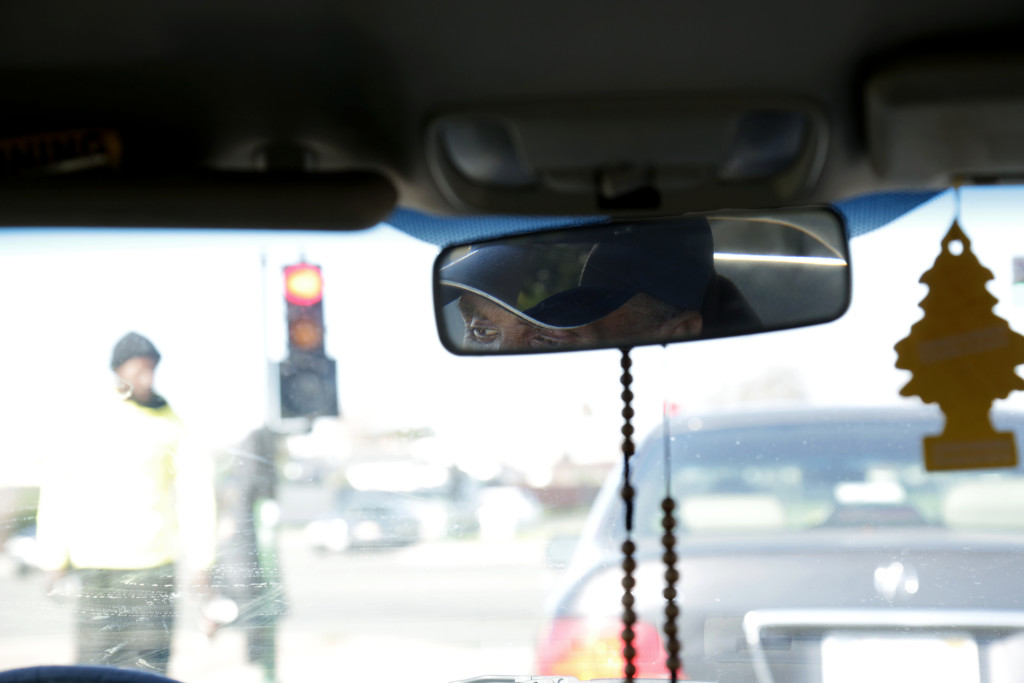
ALISSA AMBROSE/STAT — Foreman, who lives in a 2000 Volvo station wagon he bought for $300, rarely drives because of severe hand and leg spasms, among other ailments.
“We have an enormous number of older people who are basically dying homeless,” said Dr. Margot Kushel, an internist and professor of medicine at the University of California, San Francisco, who studies health care issues involving the homeless. “It’s almost an absurdity. It makes no sense at all.”
The roots of the issue are well understood, and they are basic. Homeless people typically have no connection to the medical system other than emergency rooms. Hospitals can manage these patients’ symptoms, but often lack the resources to discharge them anywhere other than the street.
Without shelter, these patients cannot take advantage of hospice care.
Foreman is actually better off than many homeless people. He has a friendly relationship with a nurse who tries to arrange visits, sometimes successfully.
And Foreman has a car that he has called home for the past several months.
On a recent night, Foreman slept on the passenger’s side. He wore two short-sleeve shirts, a stained brown sweatshirt, and a gray canvas skipper jacket, the hood pulled over a White Sox cap. His clothes may have fit him at his normal weight of nearly 170 pounds. Now he weighs under 100.
The night before, temperatures had dropped into the 40s. Foreman said he had wanted his sneakers for warmth, but his feet were swollen with fluid, too swollen for shoes.
Now, at midday and bathed in sunlight, the car was warm and the windows open to the sound of chickens clucking, pit bulls barking, and an eight-lane thoroughfare.
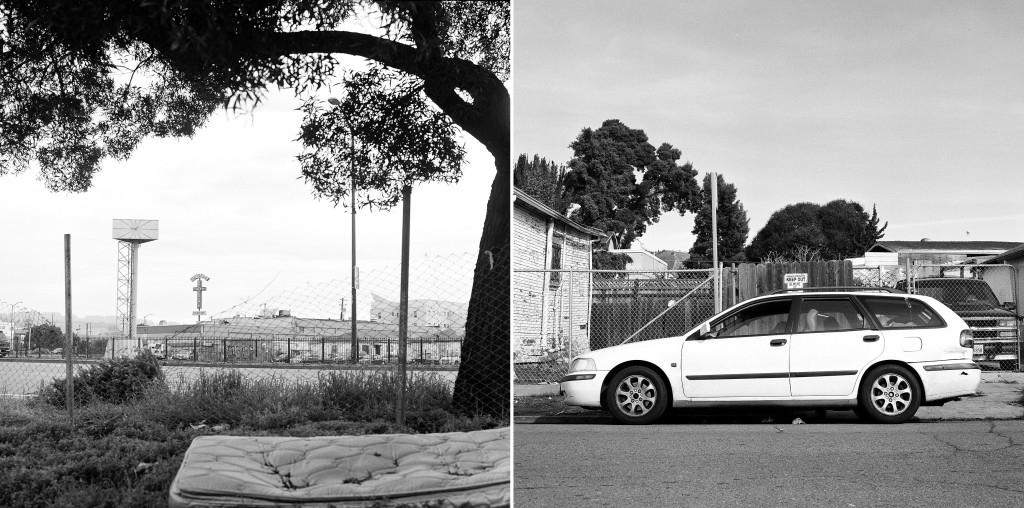
ALISSA AMBROSE/STAT–Left: A view from the East Oakland cul-de-sac where Foreman will spend nights parked in his car. Right: Foreman rests in the front seat of his car, which has become his only consistent shelter.
Foreman’s car is neatly kept. Inside it smells of air freshener, stale cigarettes, and sweat. In the rear, plastic bags peek from beneath a tossed sleeping bag. Somewhere back there are his HIV medications, his breathing treatments, maybe some pain pills. He hasn’t taken the HIV drugs for several weeks, nor has he received his methadone treatments. He eats very little.
In the back pocket of the passenger seat is a bottle of bleach for his needles. He shoots heroin “now and then,” he said.
His addiction started in 1970, when a former Army sergeant named Tanker sat him on a bed and helped set a needle in Foreman’s right arm. His previous addiction, alcohol, had started not long after his father appeared at his wedding in Los Angeles. Dwane was 17, and it was the first time he’d met his father.
His parents reconciled, briefly, with Foreman, his new wife, and their infant daughter taking a room in the house. About a month after the wedding, his mother stopped buying alcohol for his father, and the yelling started. One day not long afterward, Foreman was sitting next to his mother at home when his father pulled out a .22 caliber revolver, pointed it at her chest, and fired. She died instantly.
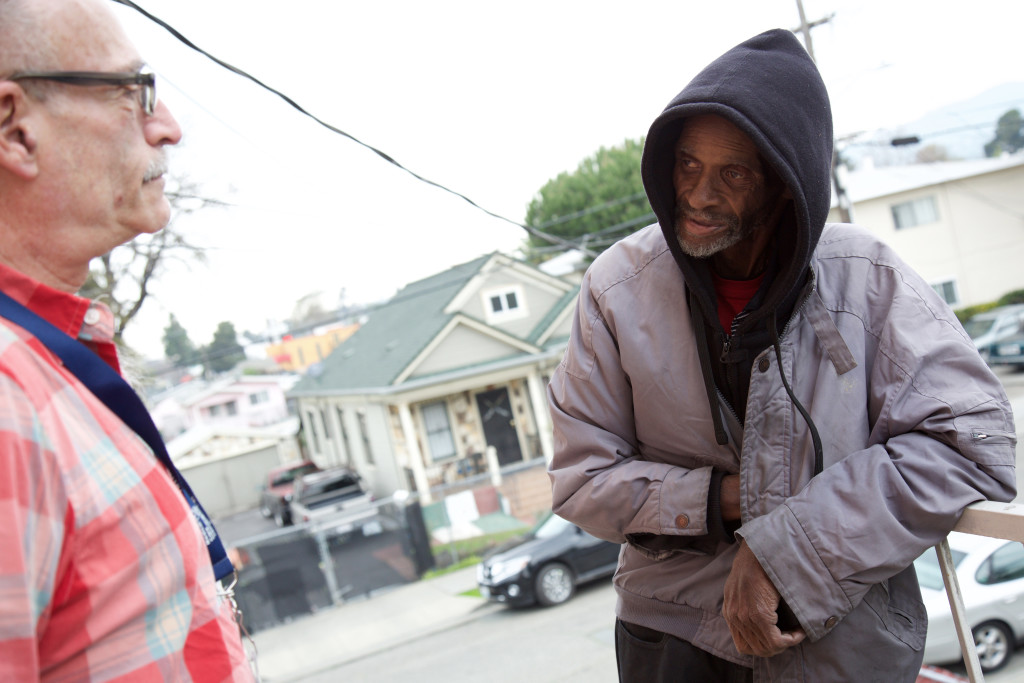
ALISSA AMBROSE/STAT–Foreman speaks with registered nurse David Greenberg in East Oakland. Greenberg, who does outreach work with the local homeless population, has known Foreman for four years.
Foreman’s wife soon moved out and went to live with her family. She took the baby, and Foreman was suddenly alone.
“I stuck around three or four weeks, but then I couldn’t hang,” he said. “That’s when I moved to Monterey.”
Foreman added four more children — one daughter in Monterey and three sons in Oakland — and made three stops at state prisons for credit card fraud, he said. In between, he earned certification as a marine mechanic and worked in a San Francisco shipyard until it shut down.
When the state took his three boys into protective custody 15 years ago — a few years after he contracted HIV through an infected needle — he decided to go clean. They are now 22, 20, and 18.
“Never have any of them used drugs, never been in jail,” he said. “They said, ‘Dad, when I’m older, I’m not gonna get into that.’”
He lived in a two-bedroom apartment until 2013, he said, but the rent jumped to $1,140 monthly; he receives $500 in monthly state assistance and does not work. Family members either did not want him staying with them or they lived in drug-heavy environments that he sought to avoid, he said, so he opted for shelters and the streets.
He said he lost his spot at a local shelter but was vague about the reasons why.
“It’s been a very bad struggle,” he said while sitting by the curb. “I can’t remember a time when I could say that I enjoyed any part of what I’m doing.”
In mid-2015, he said, he started losing weight; that November he was admitted to a hospital with pneumonia. A chest scan revealed lung cancer, and he received radiation treatment and was told to return last month for follow-up exams. He missed the appointment.
“My body is shutting down on me,” he said. “I’m just trying to get a roof over my head so I don’t have to die out here on these streets. I’m very worried about that. Being on the streets and somebody finding me dead.”
Two nights later, sitting in the passenger seat of his car, Foreman was more specific. “Thinking about dying in this car, which I probably will, I just don’t want to be in pain,” he said. “It’s very possible it could happen pretty soon. And I know it.”
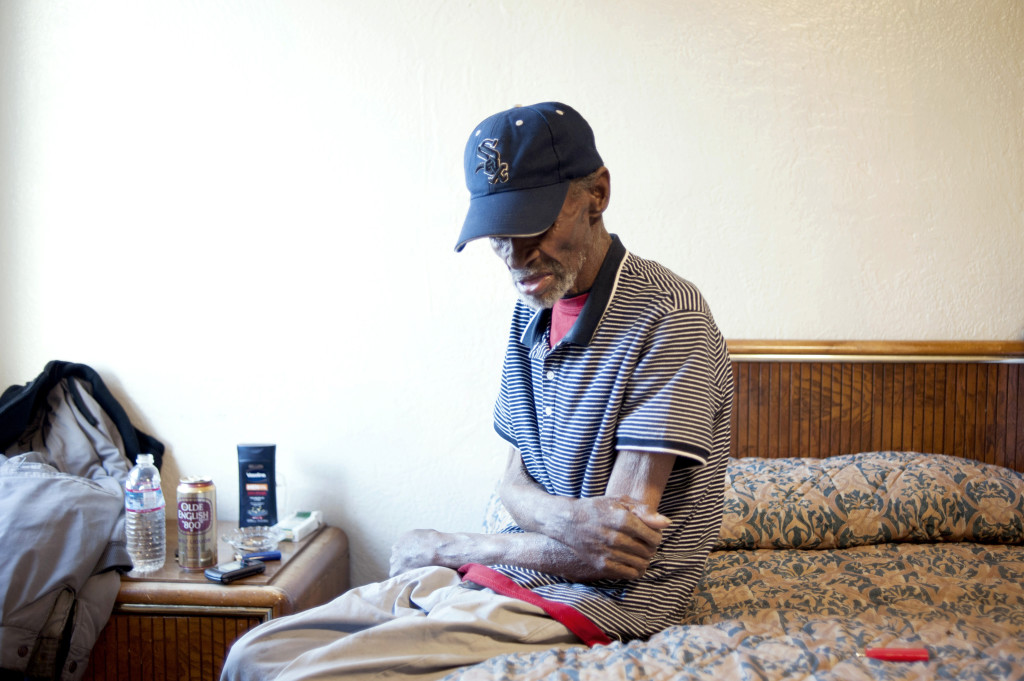
ALISSA AMBROSE/STAT–Foreman rests in an $80 motel room in East Oakland. His monthly income is about $500, and he can rarely afford such luxury.
Few options for those in need
Patients who are at the end stages of chronic obstructive pulmonary disease and lung cancer sometimes experience severe pain. They might also gasp uncontrollably up to 40 or more times per minute, leaving them breathless and panicked. (The typical adult takes 12 to 20 breaths per minute.)
Palliative care and hospice specialists can control those symptoms with morphine and anti-anxiety medications. For the homeless, however, there is often no place to administer these treatments.
Oakland is typical of most cities in this regard, said Dr. Robert Ratner, director of housing services for Alameda County Health Care Services, a public agency. Most city homeless shelters discharge residents during the daytime, and publicly funded respite centers, which are for people with special needs who are recovering from outpatient surgery, generally cannot provide intensive around-the-clock care.
Permanent housing facilities for the homeless have long waiting lists.
Homeless people with life-threatening conditions sometimes make their way to emergency rooms, but not always. Many “can bear suffering to an extent we can’t imagine,” said Dr. Rachel Solotaroff, chief medical director of Central City Concern, an anti-poverty agency in Portland, Ore.
There are scattered options for homeless people who are nearing death.
Small nonprofit organizations, like Welcome Home of Chattanooga and Joseph’s House, in Washington, D.C., have transformed private homes into shelters where visiting nurses and doctors can provide hospice care to residents.
Homeless advocates and health care professionals point to one large-scale initiative, the Boston Health Care for the Homeless Program, as a model for serving this population at life’s end.
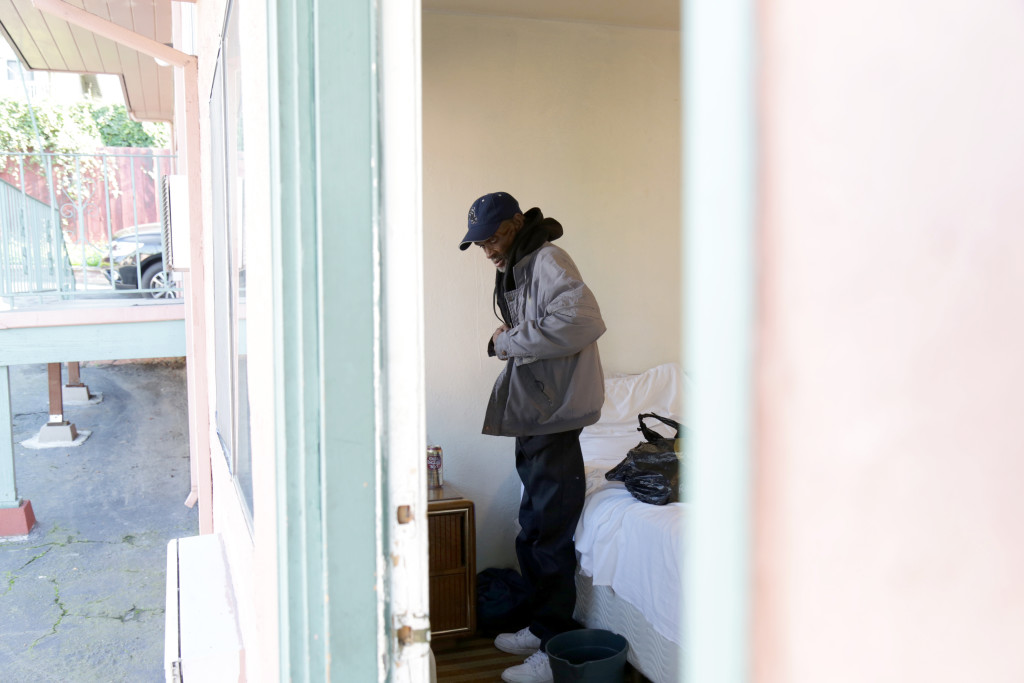
ALISSA AMBROSE/STAT–Foreman prepares to leave his room at an East Oakland motel, where he stayed for one night to escape the cold.
There, on the top floors of the former city morgue, are 104 beds offering temporary respite care for homeless patients with acute medical needs, many of whom have previously been treated on the street by the organization’s staff. Dying patients receive hospice care in private rooms, in stark contrast to homeless people in other cities.
“Most of these folks are alone, facing all the things that would freak us out,” said Dr. James J. O’Connell, cofounder and executive director of the center. “As you get to know the people doing that, it becomes almost impossible not to figure out a way to help them, because it’s an incredibly lonely death.”
But Boston’s model is unique. Several years after its inception in 1985, and with heavy lobbying from the state’s hospital association, Massachusetts agreed to use its Medicaid funds for the respite facility as a “special project,” O’Connell said.
It is a singular exception to rules governing Medicaid reimbursement for respite care, and other cities seeking to mesh homeless-outreach services with inpatient facilities for end-of-life care have not found other means to replicate the system.
“I’m guessing everybody will do this once the funding comes,” O’Connell said. “It’s not a lack of will or creativity, it’s just a lack, I think, of recognizing the problem.”
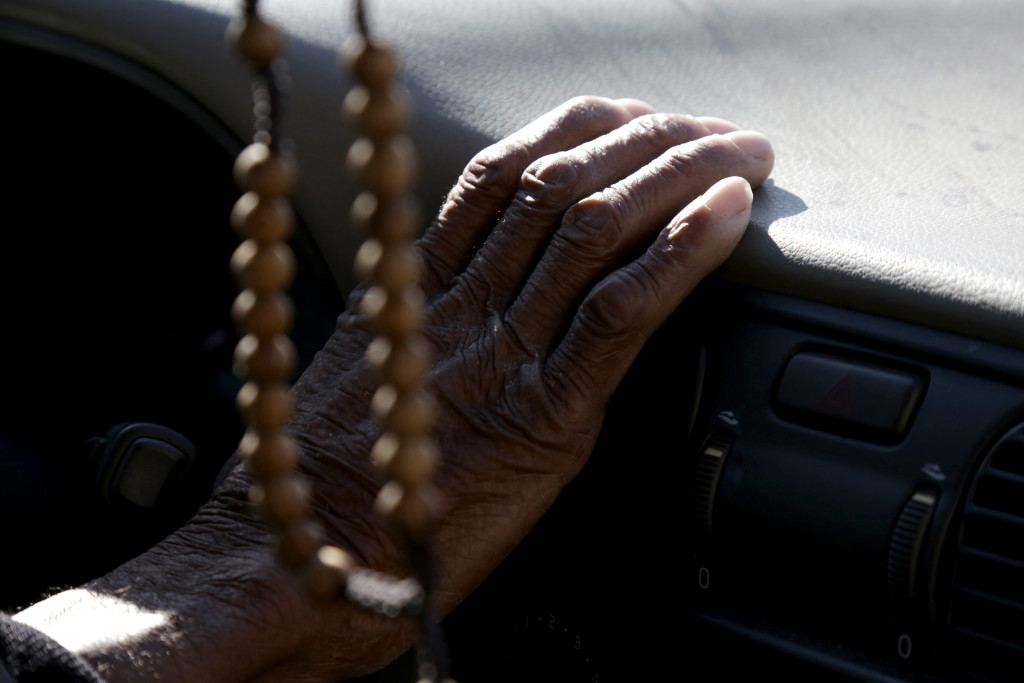
ALISSA AMBROSE/STAT–Foreman in his car in East Oakland. He suffers from chronic pain and cramping in his hands that often makes it hard for him to drive.
A simple wish
Dwane Foreman’s cousin and sons occasionally drop by the neighborhood to check on him; acquaintances who are also homeless sometimes drive Foreman’s car for him in exchange for a night in the driver’s seat. They know him as Pops or Uncle Wayne, and they help him out of his car when he can’t lift himself.
Foreman said he doesn’t want to go to the hospital only to be discharged onto the streets, as has happened repeatedly in the past. What he wants, he said, is a place where he can sleep better and prepare meals so he can nurse himself back to health.
“I would like to just live a little longer, that’s all. That’s about the best I can say. Enjoy whatever life has left for me. Spend time with my children and stuff and my family. That’s about it,” he said. “Try to get myself in better health, mainly. If I had the means, I would work on that.”
Update: Early this month, a friend found Foreman unresponsive in his car, and called emergency services. He was brought to an Oakland hospital and, as of Monday, was in the intensive care unit.
Read more by Bob Tedeschi at STAT by clicking here.
Bob Tedeschi, senior writer, covers the patients beat. He was previously a columnist and feature writer for the New York Times for 16 years, where he covered issues ranging from business technology to personal finance, among many others.
